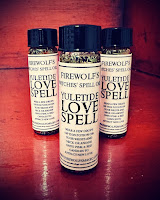Brumalia Magick Collection Now Available! @Superstitious
Brumalia - November 24th - December 25th
In our Witches’ Tradition, the Winter Solstice festivity is observed as “Brumalia”. It occurs from November 24th until December 25th. In ancient Rome, Brumalia was a month-long vigil celebrated in honor of the Agricultural Deities: Ceres and Saturn. They were presented offerings and libations of: fruits, grains, wine, olive oil, flowers, and honey. Brumalia marked the astronomic winter solstice; the time of dark intermission that concluded on ‘Natalis Solus Invicti’ or the Feast of Sol Invictus. Ancient Brumalia festivities included nighttime feasting, bonfires, dancing, singing and sacred rites of divination and fortune-telling. During the Brumalia holiday we hold candle-lit vigils in our homes and focus our magick towards protection, prosperity, clearing roads, and attracting good fortune. During this time; we as Witches say farewell to the Spirit of the Old Year and celebrate the rebirth of the Sun God. We present offerings to the Great Mother Goddess in hopes of future abundance, protection and longevity for ourselves and those who we deeply cherish. We kindle our hearths and light small bonfires to draw in the last remaining rays of light of the old year.
Yule - The Winter Solstice, December 19th-21st
In the Northern Hemisphere the Winter Solstice occurs between December 19th to December 21st. It is the shortest day of the year and therefore the longest night. In the Celtic Tradition, the battle between the Holly King and Oak King is celebrated and often re-enacted in sacred ritual. It’s the Holly King time to descend into the underworld to allow the Oak King to be reborn and grow to later fertilize the land in spring. In days of old, families would gather for feasts and celebrations to “call back” the Sun. Families spent much of the cold months together to share food and the warmth of the fire. Evergreen Wreaths were often crafted and hung on doors – symbolizing the wheel of the year and the cycles of life.
Natalis Solus Invicti - Feast of Sol Invictus, December 25th
In our Witches Tradition, at sunrise on December 25th we celebrate Natalis Solus Invicti or the Feast of Sol Invictus - the birthday of the Sun God Sol Invictus ‘the Invincible Sun’. It has been speculated that the early Church chose this date as the birth of Christ in its attempt to replace the ancient pagan festival. This sacred and powerful day is held in veneration of the birth of the Sun God and the Waxing of the Year. Many rise early to witness the rising Sun and later celebrate His birth with feasting and dancing. In our Witches’ Tradition we exchange gifts, cast spells to manifest wishes, and ring bells throughout the home to expel baneful spirits and welcome in benevolent spirits. The Rising Sun God is presented with offerings of candles, fresh water, pastries, fruits, and soft smelling incense.
Capodanno - New Year’s Day, A Time of Blessing, December 31st - January 1st
New Year’s Eve and New Year’s Day is celebrated all throughout the world. Its origin and customs are rooted in ancient Babylonia. In our Witches’ Tradition, New Year’s Eve and New Year’s Day is celebrated in unison. On December 31st we focus on protection of the home and family and January 1st ‘Capodanno’ we focus on attracting wealth, prosperity and abundance in the forthcoming year. In Italy, December 31st is connected to San Silvestro (or Saint Silvester). He was invoked by ancient farmers and shepherds to ward off wolves and the other dangers that threaten livestock. It is often conjectured that San Silvestro may be connected to the somewhat mischievous pagan God Silvanus – an ancient God (or group of gods: the silvani) of the Countrywide, Woodlands and Animals.
The New Year Festivities are filled with many ancient traditions, customs and superstitions. An old tradition involves keeping a Silver Coin (or Coins in general) in your pocket until the morning of January 1st to ensure future prosperity and abundance. In Italy on New Year’s Eve, all of the lights in the home are extinguished and all inhabitants close their eyes. When the clock strikes 12:01, all open their eyes and welcome the New Year. On New Year’s Eve; rituals of protection are conducted to ward off evil and baneful spirits. These rituals include firework displays, the breaking of glassware, and the tossing of unwanted objects out the window - representing “letting go” of the Old Year and that which we wish to no longer carry. It is said that a Yule Log burned on New Year’s Eve will ward off evil forces and spirits from the home and invoke the forces of the Great Witches’ Goddess. The ashes are often collected and saved for later use; usually in rites of protection where the ashes are simply sprinkled to ward off malevolence and disease.
On New Year’s Day, rites of prosperity and attracting wealth are conducted along with celebrations and feasting. Our home Altars are embellished in colors of red, green and orange, and adorned with bowls of Beans, Figs, Dates, Grapes, Nuts, Honey, Laurel Leaves, and Pomegranates. Each is believed to manifest and attract good fortune, prosperity and clear roads. Food also plays an important role in the New Year Festivities; large feasts are held with family and friends and traditional foods are prepared using ingredients believed to attract wealth and prosperity. These dishes are created using Beans, Black Eyed Peas, Dates, Figs, Honey, Grapes & Raisins.
Brumalia Magick Collection Now Available!






Comments
Post a Comment